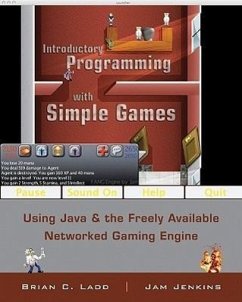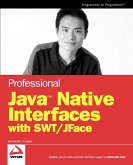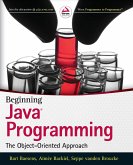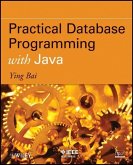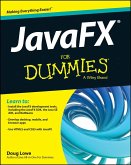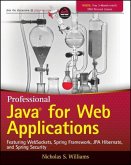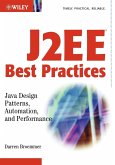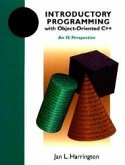Brian C Ladd, Christopher James Jenkins
Introductory Programming with Simple Games
Using Java and the Freely Available Networked Game Engine
Brian C Ladd, Christopher James Jenkins
Introductory Programming with Simple Games
Using Java and the Freely Available Networked Game Engine
- Broschiertes Buch
- Merkliste
- Auf die Merkliste
- Bewerten Bewerten
- Teilen
- Produkt teilen
- Produkterinnerung
- Produkterinnerung
This is an excellent resource for programmers who need to learn Java but aren't interested in just reading about concepts. Introduction to Java Programming with Games follows a spiral approach to introduce concepts and enable them to write game programs as soon as they start. It includes code examples and problems that are easy to understand and motivates them to work through to find the solutions. This game-motivated presentation will help programmers quickly apply what they've learned in order to build their skills.
Andere Kunden interessierten sich auch für
![Professional Java Native Interfaces with SWT/JFace Professional Java Native Interfaces with SWT/JFace]() Jack Li GuojieProfessional Java Native Interfaces with SWT/JFace45,99 €
Jack Li GuojieProfessional Java Native Interfaces with SWT/JFace45,99 €![Beginning Java Programming Beginning Java Programming]() Bart BaesensBeginning Java Programming35,99 €
Bart BaesensBeginning Java Programming35,99 €![Practical Database Programming with Java Practical Database Programming with Java]() Ying BaiPractical Database Programming with Java114,99 €
Ying BaiPractical Database Programming with Java114,99 €![Javafx for Dummies Javafx for Dummies]() Doug LoweJavafx for Dummies29,99 €
Doug LoweJavafx for Dummies29,99 €![Professional Java for Web Appl Professional Java for Web Appl]() Nicholas S. WilliamsProfessional Java for Web Appl56,99 €
Nicholas S. WilliamsProfessional Java for Web Appl56,99 €![J2ee Best Practices J2ee Best Practices]() Darren BroemmerJ2ee Best Practices34,99 €
Darren BroemmerJ2ee Best Practices34,99 €![Introductory Programming with Object-Oriented C++ Introductory Programming with Object-Oriented C++]() Jan L HarringtonIntroductory Programming with Object-Oriented C++189,99 €
Jan L HarringtonIntroductory Programming with Object-Oriented C++189,99 €-
-
-
This is an excellent resource for programmers who need to learn Java but aren't interested in just reading about concepts. Introduction to Java Programming with Games follows a spiral approach to introduce concepts and enable them to write game programs as soon as they start. It includes code examples and problems that are easy to understand and motivates them to work through to find the solutions. This game-motivated presentation will help programmers quickly apply what they've learned in order to build their skills.
Produktdetails
- Produktdetails
- Verlag: Wiley
- Seitenzahl: 528
- Erscheinungstermin: 29. März 2010
- Englisch
- Abmessung: 251mm x 201mm x 18mm
- Gewicht: 839g
- ISBN-13: 9780470212844
- ISBN-10: 0470212845
- Artikelnr.: 31573015
- Herstellerkennzeichnung
- Libri GmbH
- Europaallee 1
- 36244 Bad Hersfeld
- gpsr@libri.de
- Verlag: Wiley
- Seitenzahl: 528
- Erscheinungstermin: 29. März 2010
- Englisch
- Abmessung: 251mm x 201mm x 18mm
- Gewicht: 839g
- ISBN-13: 9780470212844
- ISBN-10: 0470212845
- Artikelnr.: 31573015
- Herstellerkennzeichnung
- Libri GmbH
- Europaallee 1
- 36244 Bad Hersfeld
- gpsr@libri.de
Brian C. Ladd and Christopher James Jenkins are the authors of Introductory Programming with Simple Games: Using Java and the Freely Available Networked Game Engine, published by Wiley.
Acknowledgments.
Forward.
1 Getting Started: What's in a Game?
1.1 Learning From Simple Computer Games.
1.2 What's In a Game?
1.3 Active and Passive: Rule Followers.
1.4 Running a Game.
1.5 Strategies: Winning a Game.
1.6 What Is in a Computer Program?
1.7 Summary.
1.8 Chapter Review Exercises.
2 Designing Your First Program.
2.1 BasketBall.
2.2 Java.
2.3 Creating Executable Programs.
2.4 Problem Solving.
2.5 FANG.
2.6 Finishing Up BasketBall.
2.7 Summary.
2.8 Chapter Review Exercises.
2.9 Programming Problems.
3 FANG: A Survey of Classes.
3.1 How Computers Work.
3.2 FANG Basics.
3.3 Examining a Public Protocol.
3.4 Summary.
3.5 Chapter Review Exercises.
3.6 Programming Problems.
4 Deciding What Happens: if.
4.1 A Simplest Game.
4.2 Computer Program (Game) Design.
4.3 Sequence.
4.4 Selection.
4.5 Finishing NewtonsApple.
4.6 Summary.
4.7 Chapter Review Exercises.
4.8 Programming Problems.
5 Components: Names, Types, Expressions.
5.1 Chance in Games.
5.2 One More Sprite: CompositeSprite.
5.3 Java Types.
5.4 Calculating with the Computer.
5.5 Naming Things in Java.
5.6 Finishing EasyDice.
5.7 Summary.
5.8 Chapter Review Exercises.
5.9 Programming Problems.
6 Rules: Methods, Parameters, and Design.
6.1 A Simple Arcade Game: SoloPong.
6.2 Top-down Design.
6.3 Delegation: Methods.
6.4 Expressions Redux.
6.5 Finishing Up SoloPong.
6.6 Summary.
6.7 Chapter Review Exercises.
6.8 Programming Problems.
7 Components Meet Rules: Classes.
7.1 Playing Together.
7.2 Abstraction: Defining New Types.
7.3 Finishing the Game.
7.4 Summary.
7.5 Chapter Review Exercises.
7.6 Programming Problems.
8 Collections: ArrayList and Iteration.
8.1 Flu Pandemic Simulator.
8.2 Console I/O: The System Object.
8.3 Iteration.
8.4 Collections: One and Many.
8.5 ArrayList Is an Object.
8.6 Finishing the Flu Simulation.
8.7 Summary.
8.8 Chapter Review Exercises.
8.9 Programming Problems.
9 Multidimensional Data Structures.
9.1 Rescue Mission.
9.2 Inheritance.
9.3 Multidimensional Collections.
9.4 Animation.
9.5 Finishing Rescue Mission.
9.6 Summary.
9.7 Chapter Review Exercises.
9.8 Programming Problems.
10 Scanner and String: Character Input.
10.1 Designing Hangman.
10.2 Starting Programs.
10.3 Different Iteration.
10.4 String Manipulation.
10.5 Reading Files.
10.6 Finishing Hangman.
10.7 Summary.
10.8 Chapter Review Exercises.
10.9 Programming Problems.
11 Console I/O: Games without FANG.
11.1 Another Dice Game: Pig.
11.2 Pure Console I/O.
11.3 Sorting a Collection.
11.4 Finishing Pig.
11.5 Summary.
11.6 Chapter Review Exercises.
11.7 Programming Problems.
12 More Streams: Separating Programs and Data.
12.1 Outsmarting the Player: Twenty Questions.
12.2 Reading and Writing Files.
12.3 Data-driven Programs.
12.4 Encoding Objects to Read or Write Them.
12.5 Finishing the Game.
12.6 Summary.
12.7 Chapter Review Exercises.
12.8 Programming Problems.
13 Lists of Lists and Collision Detection.
13.1 Designing BlockDrop.
13.2 Software Engineering: Managing Complexity.
13.3 When It's Safe to Move: Collision Detection.
13.4 Finishing BlockDrop.
13.5 Summary.
13.6 Chapter Review Exercises.
13.7 Programming Problems.
14 String Processing: Interactive Fiction.
14.1 Back to the Future: Interactive Fiction.
14.2 Escape from T-Hall.
14.3 Reading the Data.
14.4 Attribute-Value Pairs.
14.5 Incremental Development.
14.6 Finding a Match.
14.7 Making It a Real Game.
14.8 Summary.
14.9 Chapter Review Exercises.
14.10 Programming Problems.
A Java Language Keywords.
B References.
C Java Templates.
D FANG Color Names.
Index.
Forward.
1 Getting Started: What's in a Game?
1.1 Learning From Simple Computer Games.
1.2 What's In a Game?
1.3 Active and Passive: Rule Followers.
1.4 Running a Game.
1.5 Strategies: Winning a Game.
1.6 What Is in a Computer Program?
1.7 Summary.
1.8 Chapter Review Exercises.
2 Designing Your First Program.
2.1 BasketBall.
2.2 Java.
2.3 Creating Executable Programs.
2.4 Problem Solving.
2.5 FANG.
2.6 Finishing Up BasketBall.
2.7 Summary.
2.8 Chapter Review Exercises.
2.9 Programming Problems.
3 FANG: A Survey of Classes.
3.1 How Computers Work.
3.2 FANG Basics.
3.3 Examining a Public Protocol.
3.4 Summary.
3.5 Chapter Review Exercises.
3.6 Programming Problems.
4 Deciding What Happens: if.
4.1 A Simplest Game.
4.2 Computer Program (Game) Design.
4.3 Sequence.
4.4 Selection.
4.5 Finishing NewtonsApple.
4.6 Summary.
4.7 Chapter Review Exercises.
4.8 Programming Problems.
5 Components: Names, Types, Expressions.
5.1 Chance in Games.
5.2 One More Sprite: CompositeSprite.
5.3 Java Types.
5.4 Calculating with the Computer.
5.5 Naming Things in Java.
5.6 Finishing EasyDice.
5.7 Summary.
5.8 Chapter Review Exercises.
5.9 Programming Problems.
6 Rules: Methods, Parameters, and Design.
6.1 A Simple Arcade Game: SoloPong.
6.2 Top-down Design.
6.3 Delegation: Methods.
6.4 Expressions Redux.
6.5 Finishing Up SoloPong.
6.6 Summary.
6.7 Chapter Review Exercises.
6.8 Programming Problems.
7 Components Meet Rules: Classes.
7.1 Playing Together.
7.2 Abstraction: Defining New Types.
7.3 Finishing the Game.
7.4 Summary.
7.5 Chapter Review Exercises.
7.6 Programming Problems.
8 Collections: ArrayList and Iteration.
8.1 Flu Pandemic Simulator.
8.2 Console I/O: The System Object.
8.3 Iteration.
8.4 Collections: One and Many.
8.5 ArrayList Is an Object.
8.6 Finishing the Flu Simulation.
8.7 Summary.
8.8 Chapter Review Exercises.
8.9 Programming Problems.
9 Multidimensional Data Structures.
9.1 Rescue Mission.
9.2 Inheritance.
9.3 Multidimensional Collections.
9.4 Animation.
9.5 Finishing Rescue Mission.
9.6 Summary.
9.7 Chapter Review Exercises.
9.8 Programming Problems.
10 Scanner and String: Character Input.
10.1 Designing Hangman.
10.2 Starting Programs.
10.3 Different Iteration.
10.4 String Manipulation.
10.5 Reading Files.
10.6 Finishing Hangman.
10.7 Summary.
10.8 Chapter Review Exercises.
10.9 Programming Problems.
11 Console I/O: Games without FANG.
11.1 Another Dice Game: Pig.
11.2 Pure Console I/O.
11.3 Sorting a Collection.
11.4 Finishing Pig.
11.5 Summary.
11.6 Chapter Review Exercises.
11.7 Programming Problems.
12 More Streams: Separating Programs and Data.
12.1 Outsmarting the Player: Twenty Questions.
12.2 Reading and Writing Files.
12.3 Data-driven Programs.
12.4 Encoding Objects to Read or Write Them.
12.5 Finishing the Game.
12.6 Summary.
12.7 Chapter Review Exercises.
12.8 Programming Problems.
13 Lists of Lists and Collision Detection.
13.1 Designing BlockDrop.
13.2 Software Engineering: Managing Complexity.
13.3 When It's Safe to Move: Collision Detection.
13.4 Finishing BlockDrop.
13.5 Summary.
13.6 Chapter Review Exercises.
13.7 Programming Problems.
14 String Processing: Interactive Fiction.
14.1 Back to the Future: Interactive Fiction.
14.2 Escape from T-Hall.
14.3 Reading the Data.
14.4 Attribute-Value Pairs.
14.5 Incremental Development.
14.6 Finding a Match.
14.7 Making It a Real Game.
14.8 Summary.
14.9 Chapter Review Exercises.
14.10 Programming Problems.
A Java Language Keywords.
B References.
C Java Templates.
D FANG Color Names.
Index.
Acknowledgments.
Forward.
1 Getting Started: What's in a Game?
1.1 Learning From Simple Computer Games.
1.2 What's In a Game?
1.3 Active and Passive: Rule Followers.
1.4 Running a Game.
1.5 Strategies: Winning a Game.
1.6 What Is in a Computer Program?
1.7 Summary.
1.8 Chapter Review Exercises.
2 Designing Your First Program.
2.1 BasketBall.
2.2 Java.
2.3 Creating Executable Programs.
2.4 Problem Solving.
2.5 FANG.
2.6 Finishing Up BasketBall.
2.7 Summary.
2.8 Chapter Review Exercises.
2.9 Programming Problems.
3 FANG: A Survey of Classes.
3.1 How Computers Work.
3.2 FANG Basics.
3.3 Examining a Public Protocol.
3.4 Summary.
3.5 Chapter Review Exercises.
3.6 Programming Problems.
4 Deciding What Happens: if.
4.1 A Simplest Game.
4.2 Computer Program (Game) Design.
4.3 Sequence.
4.4 Selection.
4.5 Finishing NewtonsApple.
4.6 Summary.
4.7 Chapter Review Exercises.
4.8 Programming Problems.
5 Components: Names, Types, Expressions.
5.1 Chance in Games.
5.2 One More Sprite: CompositeSprite.
5.3 Java Types.
5.4 Calculating with the Computer.
5.5 Naming Things in Java.
5.6 Finishing EasyDice.
5.7 Summary.
5.8 Chapter Review Exercises.
5.9 Programming Problems.
6 Rules: Methods, Parameters, and Design.
6.1 A Simple Arcade Game: SoloPong.
6.2 Top-down Design.
6.3 Delegation: Methods.
6.4 Expressions Redux.
6.5 Finishing Up SoloPong.
6.6 Summary.
6.7 Chapter Review Exercises.
6.8 Programming Problems.
7 Components Meet Rules: Classes.
7.1 Playing Together.
7.2 Abstraction: Defining New Types.
7.3 Finishing the Game.
7.4 Summary.
7.5 Chapter Review Exercises.
7.6 Programming Problems.
8 Collections: ArrayList and Iteration.
8.1 Flu Pandemic Simulator.
8.2 Console I/O: The System Object.
8.3 Iteration.
8.4 Collections: One and Many.
8.5 ArrayList Is an Object.
8.6 Finishing the Flu Simulation.
8.7 Summary.
8.8 Chapter Review Exercises.
8.9 Programming Problems.
9 Multidimensional Data Structures.
9.1 Rescue Mission.
9.2 Inheritance.
9.3 Multidimensional Collections.
9.4 Animation.
9.5 Finishing Rescue Mission.
9.6 Summary.
9.7 Chapter Review Exercises.
9.8 Programming Problems.
10 Scanner and String: Character Input.
10.1 Designing Hangman.
10.2 Starting Programs.
10.3 Different Iteration.
10.4 String Manipulation.
10.5 Reading Files.
10.6 Finishing Hangman.
10.7 Summary.
10.8 Chapter Review Exercises.
10.9 Programming Problems.
11 Console I/O: Games without FANG.
11.1 Another Dice Game: Pig.
11.2 Pure Console I/O.
11.3 Sorting a Collection.
11.4 Finishing Pig.
11.5 Summary.
11.6 Chapter Review Exercises.
11.7 Programming Problems.
12 More Streams: Separating Programs and Data.
12.1 Outsmarting the Player: Twenty Questions.
12.2 Reading and Writing Files.
12.3 Data-driven Programs.
12.4 Encoding Objects to Read or Write Them.
12.5 Finishing the Game.
12.6 Summary.
12.7 Chapter Review Exercises.
12.8 Programming Problems.
13 Lists of Lists and Collision Detection.
13.1 Designing BlockDrop.
13.2 Software Engineering: Managing Complexity.
13.3 When It's Safe to Move: Collision Detection.
13.4 Finishing BlockDrop.
13.5 Summary.
13.6 Chapter Review Exercises.
13.7 Programming Problems.
14 String Processing: Interactive Fiction.
14.1 Back to the Future: Interactive Fiction.
14.2 Escape from T-Hall.
14.3 Reading the Data.
14.4 Attribute-Value Pairs.
14.5 Incremental Development.
14.6 Finding a Match.
14.7 Making It a Real Game.
14.8 Summary.
14.9 Chapter Review Exercises.
14.10 Programming Problems.
A Java Language Keywords.
B References.
C Java Templates.
D FANG Color Names.
Index.
Forward.
1 Getting Started: What's in a Game?
1.1 Learning From Simple Computer Games.
1.2 What's In a Game?
1.3 Active and Passive: Rule Followers.
1.4 Running a Game.
1.5 Strategies: Winning a Game.
1.6 What Is in a Computer Program?
1.7 Summary.
1.8 Chapter Review Exercises.
2 Designing Your First Program.
2.1 BasketBall.
2.2 Java.
2.3 Creating Executable Programs.
2.4 Problem Solving.
2.5 FANG.
2.6 Finishing Up BasketBall.
2.7 Summary.
2.8 Chapter Review Exercises.
2.9 Programming Problems.
3 FANG: A Survey of Classes.
3.1 How Computers Work.
3.2 FANG Basics.
3.3 Examining a Public Protocol.
3.4 Summary.
3.5 Chapter Review Exercises.
3.6 Programming Problems.
4 Deciding What Happens: if.
4.1 A Simplest Game.
4.2 Computer Program (Game) Design.
4.3 Sequence.
4.4 Selection.
4.5 Finishing NewtonsApple.
4.6 Summary.
4.7 Chapter Review Exercises.
4.8 Programming Problems.
5 Components: Names, Types, Expressions.
5.1 Chance in Games.
5.2 One More Sprite: CompositeSprite.
5.3 Java Types.
5.4 Calculating with the Computer.
5.5 Naming Things in Java.
5.6 Finishing EasyDice.
5.7 Summary.
5.8 Chapter Review Exercises.
5.9 Programming Problems.
6 Rules: Methods, Parameters, and Design.
6.1 A Simple Arcade Game: SoloPong.
6.2 Top-down Design.
6.3 Delegation: Methods.
6.4 Expressions Redux.
6.5 Finishing Up SoloPong.
6.6 Summary.
6.7 Chapter Review Exercises.
6.8 Programming Problems.
7 Components Meet Rules: Classes.
7.1 Playing Together.
7.2 Abstraction: Defining New Types.
7.3 Finishing the Game.
7.4 Summary.
7.5 Chapter Review Exercises.
7.6 Programming Problems.
8 Collections: ArrayList and Iteration.
8.1 Flu Pandemic Simulator.
8.2 Console I/O: The System Object.
8.3 Iteration.
8.4 Collections: One and Many.
8.5 ArrayList Is an Object.
8.6 Finishing the Flu Simulation.
8.7 Summary.
8.8 Chapter Review Exercises.
8.9 Programming Problems.
9 Multidimensional Data Structures.
9.1 Rescue Mission.
9.2 Inheritance.
9.3 Multidimensional Collections.
9.4 Animation.
9.5 Finishing Rescue Mission.
9.6 Summary.
9.7 Chapter Review Exercises.
9.8 Programming Problems.
10 Scanner and String: Character Input.
10.1 Designing Hangman.
10.2 Starting Programs.
10.3 Different Iteration.
10.4 String Manipulation.
10.5 Reading Files.
10.6 Finishing Hangman.
10.7 Summary.
10.8 Chapter Review Exercises.
10.9 Programming Problems.
11 Console I/O: Games without FANG.
11.1 Another Dice Game: Pig.
11.2 Pure Console I/O.
11.3 Sorting a Collection.
11.4 Finishing Pig.
11.5 Summary.
11.6 Chapter Review Exercises.
11.7 Programming Problems.
12 More Streams: Separating Programs and Data.
12.1 Outsmarting the Player: Twenty Questions.
12.2 Reading and Writing Files.
12.3 Data-driven Programs.
12.4 Encoding Objects to Read or Write Them.
12.5 Finishing the Game.
12.6 Summary.
12.7 Chapter Review Exercises.
12.8 Programming Problems.
13 Lists of Lists and Collision Detection.
13.1 Designing BlockDrop.
13.2 Software Engineering: Managing Complexity.
13.3 When It's Safe to Move: Collision Detection.
13.4 Finishing BlockDrop.
13.5 Summary.
13.6 Chapter Review Exercises.
13.7 Programming Problems.
14 String Processing: Interactive Fiction.
14.1 Back to the Future: Interactive Fiction.
14.2 Escape from T-Hall.
14.3 Reading the Data.
14.4 Attribute-Value Pairs.
14.5 Incremental Development.
14.6 Finding a Match.
14.7 Making It a Real Game.
14.8 Summary.
14.9 Chapter Review Exercises.
14.10 Programming Problems.
A Java Language Keywords.
B References.
C Java Templates.
D FANG Color Names.
Index.

